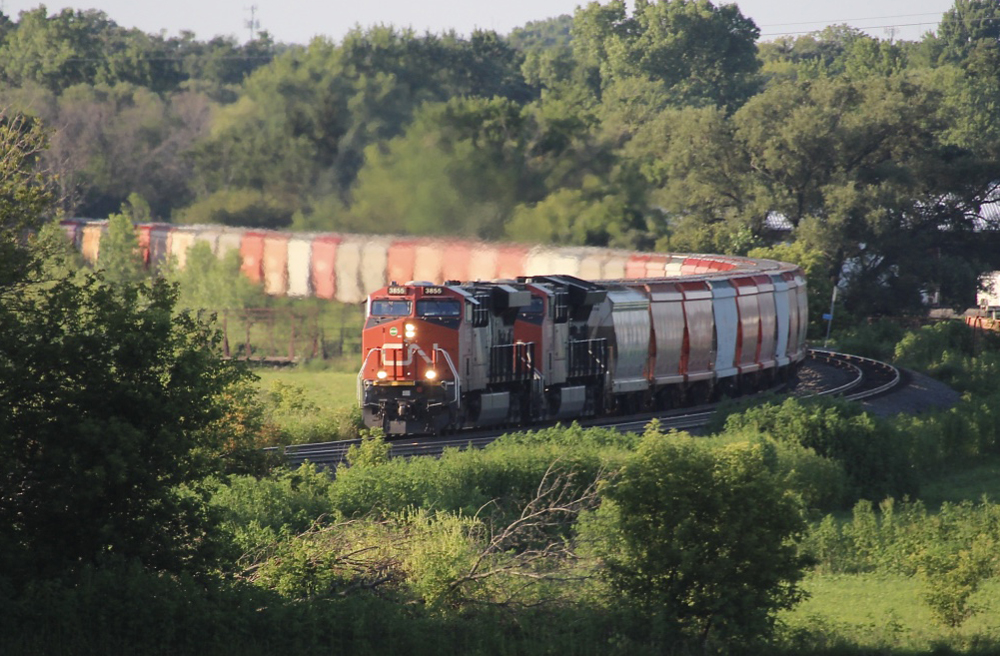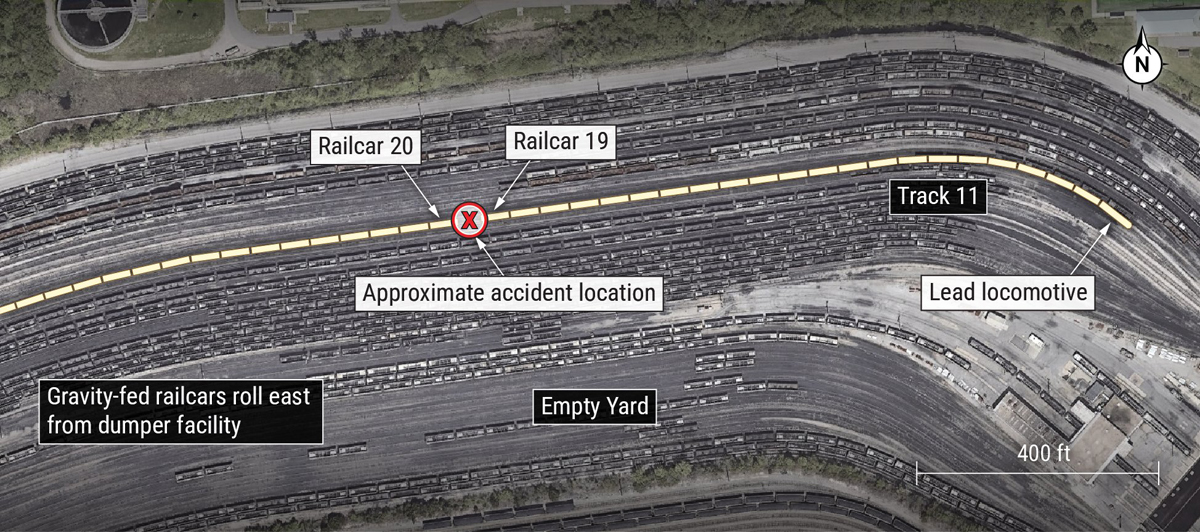
BERKELEY, Calif. — A new study says railroads could save $94 billion over 20 years by reducing air pollution and carbon dioxide emissions — and help avoid health impacts including an estimated 1,000 premature deaths each year — by retrofitting diesel-electric locomotives with battery power.
The study from the U.S. Department of Energy’s Lawrence Berkeley National Laboratory, in collaboration with UCLA and UC Berkeley researchers, says the conversion could be accomplished in a cost-competitive manner, in part through the use of battery tenders, cars carrying battery units, while leaving the diesel engine in place as a backup power source. The study was published in the journal Nature Energy.
“A rapid conversion of the freight-rail sector is not only technically feasible and cost-effective, it would bring immediate and lasting health and economic benefits to lower-income communities,” Natalie Popovich, Berkeley Lab scientist and lead author of the study, said in a Berkeley Lab article. “And it would provide a boost to our nation’s efforts to curb climate change, especially considering that U.S. freight rail capacity is expected to double by 2050.”
Amol Phadke, a Berkeley Lab scientist and coauthor of the study, said dramatic improvements in battery technology make the conversion feasible, and that battery weight is less of an issue for trains than for other forms of transportation: “We can add a car to a freight train built out with batteries, and the weight of that battery car is not an issue.”
Phadke sees another potential benefit of the use of battery tenders: they could be used as mobile power sources “during extreme events, such as during the recent catastrophic wildfires in California or the 2021 winter storm in Texas that left millions without access to electricity. This mobile energy storage capability would also create a potential new revenue stream for freight rail operators.”














“Zero Emissions” is a complete fallacy. While it may be true that the locomotive may not emit any gaseous emissions, but the impact to the environment from the manufacturing processes, including the extraction, and transportation of the raw materials must be factored in. Disposal of the worn out components must also be factored into the equation.
The idea that regenerative braking will keep the storage batteries charged is also a fallacy. Any downtime incurred due to recharging the batteries must be looked at, a locomotive that has an availability rate less than 90% isn’t going to sell in the current industry.
It is nice to see the research and development investment, but today’s technology is not going to work worth a darn.
NYC used three-power motors (third rail, battery, diesel) on its West Side Line (High Line) in NY City starting in the 1920’s.
Diesels were IR 6-cylinder 300 HP; the batteries were Exide lead-acid;electrical gear was GE. Mostly they ran on third rail power but used the diesels to charge the batteries and the batteries for movement off third rail such as inside buildings.
Trains can see the battery operated Milwaukee light rail as an predecessor of the railroads.
Imagine battery locomotives charged not from old diesels, but centenary except only 20% as much centenary as a conventional electric operation – giving us electrification on the cheap.
Charles reaches for his recycling bin for a study . . . I reach for my wallet. Comment all you want about the money spent for studies, the fact is if you are going to invest real funds, you want some analysis of results beforehand. No bank will give you a loan without a business plan – which is what a study is.
You don’t event need to reach for a study, JR East has already been running a half catenary/half battery passenger line for a few years now with the EV-E801. But to American railroaders, the rest of the world doesn’t exist.
CATENARY!! CAT-enary in this country; CA-TEEN-ary in Britain. Yes, the New Haven had an experimental stretch of “Dogenary” just east of Stamford CT (dog-leg catenary in reality) but dog-enary describes the now-replaced stretch perfectly.
The future is upon us and some of us don’t want to face it, those that don’t will be holding a sign saying “The Sky Is Falling, The Sky Is Falling”.
While I agree with Charles’ skepticism for the validity of many such studies, I do see merit in the argument that the improvements of batteries will likely mean they play a much bigger role in railroad motive power regardless of whatever climate policies are enacted.
Firstly, batter locomotives enable regular diesels to essentially act like a prius–this is what Wabtec is testing out right now. This is simple and has been a long time coming. Secondly, and much more potentially groundbreaking, battery locomotives makes railroad electrification vastly more appealing.
Electric railways are superior to diesels in all aspects save two: reliability and initial capital cost. Batteries can cut costs dramatically and improve reliability vs straight electrification. Electrification cost killers such as sidings, low clearance tunnels and overpasses, stretches of track far away from transmission lines can all be skipped. If the cost of the initial outlay can be brought down in this manner, electrification becomes appealing.
Yes electricity obviously costs money, but the cost per btu applied at the railhead is consistently far lower than the cost of diesel per btu applied at the railhead. Tier 4 diesels are getting so darn complicated and batteries are plummeting in cost so much that the day when a battery/straight electric hybrid locomotive is cheaper and less costly to maintain than a diesel may not be far off.
seems intresting
“And it would provide a boost to our nation’s efforts to curb climate change, especially considering that U.S. freight rail capacity is expected to double by 2050.”
This is a red herring. You still have to get the electricity to charge the battery from somewhere. The wind doesn’t always blow and the sun doesn’t always shine in a clear blue sky, or at night for that matter. That leaves traditional sources of electricity to charge the batteries; carbon based, hydro or nuclear. All you are doing is trading a point source pollution for a non-point source of pollution.
This reminds me of a study done in California a few years back. There was a furor over nitrogen in ground water coming from dairies. (The nitrogen was getting into drinking water and causing “blue baby” syndrome.) Lo and behold, the study found that dairies were a point source of nitrogen and the drinking water was a non-point source of nitrogen. Go figure.
Sarcasm button on. Conductor: Ahhh, dispatcher, this is 4567 East. We need to tie down on the main here on the hill. About three-quarters of the way up.
Gonna need about 80 cars to keep from rolling back down the hill. Dispatcher: What seems to be the problem? Conductor: Ran out of battery power. The power management system said we had enough battery capacity to pull 9,000 tons and 14,000 trailing feet up the hill. Dispatcher: OK. Let me get ahold of the power desk. I think they have a set of old SD40-2s available to pull you up the hill. Conductor: What is their ETA to the hill? Dispatcher: Should be about 3 hours. Wait. I have to verify if we have carbon credits available. Never mind. I’ll send a taxi for you. Conductor: Roger that. Tying the train down. Sarcasm button off.
“while leaving the diesel engine in place as a backup power source”.
Basically the same as a hybrid car.
Yes. Exactly. The Public Service of NJ’s All-Service Vehicles applies to freight rail. The All-Service Vehicles were trackless trolleys with gasoline engine that powered generators away from the wires. They existed, all 584 of ’em, because PS of NJ had a big fleet of gasoline-electric busses and realized they used the same engines as the trackless trolleys. Gasoline-electric drive was a way around the manual transmission problem until a bus hydraulic transmission was perfected. Of course how much dead weight would be involved in these batteries and how well would charging and re-charging them work? Think it through. But the only really sure way to reduce emissions would be to use nuclear-produced power and I think nuclear is still the Other N-Word in environmental circles! One nuclear plant could service an entire large RR. Furthermore could spent and charged batteries be swapped at various central locations? Think it through and work it out! Oddly enough, the other day I was reading in KALMBACH’s archives about the RRs’ experience with Diesel-hydraulic drive in the 1960’s–which ultimately didn’t pan out except in the Budd RDC.
Of all the modern battery systems , i haven’t seen one that involves physically removing the batteries to recharge them. Most of the modern European models or proposals are used on extensions of electrification , and use a pantograph for charging , so there is not even any plugging in etc . The idea is to have short sections of catenary at stations etc , so the amount of battery storage required is smaller.
The late Sen, Theodore Bilbo of Mississippi is remembered for saying, “When I hear the word ‘culture’ I reach for my gun”. Well I don’t own a gun, never have never will. Let me put it this way: “When I read the word ‘study’ I reach for the recycling bin.
Kinda tells.
And that’s why American railroads are stuck in the last century, and seeing themselves up for massive failure.